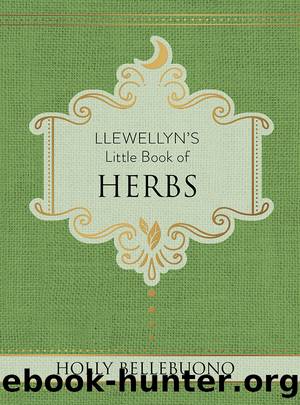Llewellyn’s Little Book of Herbs by Holly Bellebuono

Author:Holly Bellebuono
Language: eng
Format: epub
Tags: CVR04262019;little book of herbs;book of herbs;herbs;herbalism;herbalism book;herbalism for beginners;llewellyn's little books;llewellyn's little book series;llewellyns little book of herbs;holly bellebuono
Publisher: Llewellyn Publications is an imprint of Llewellyn Worldwide Ltd.
Published: 2020-03-05T20:53:16+00:00
tip 4
Baskets and Bags
Instead of keeping your gathering equipment outside, find a place just inside your door to keep it, and train yourself to return your baskets and bags to their spot when you’re finished. Hanging baskets on hooks from a rafter or on the wall is a great way to show off a pretty and functional item.
break
Harvesting Flowers and Leaves
If you have a love for herbs, you’ll likely spend your spring and summer harvesting succulent young violet leaves to eat in your salad, velvety mallow leaves to tuck into fairy beds, or bright green lemon balm leaves to make into medicinal syrups and tinctures. You’ll pick feathery yarrow leaves and strip the soft bits from the stem right onto your cutting board. You’ll snap off entire leaf sets from elder bushes, and you’ll gather flowers of every color you can imagine: creamy-white yarrow, lilac-colored sage, crimson bee balm, and sunshine-infused calendula petals. When harvesting, follow these tips to get the most from the leaves and flowers:
• Consider the phase of the moon, and harvest above-ground (aerial) parts such as leaves, flowers, and seeds on the full moon, when the energy is pulling upward from the earth. The energy from the plants will be in the above-ground parts, whereas at the new moon the energy will be underground.
• The best time to harvest, especially on hot days, is mid-morning. Wait until the dew has evaporated from the leaves and they are fairly dry, but don’t wait too long because the midday sun will wilt the plants and weaken them. Dusk is also a good time to harvest, but mosquitoes can be troublesome.
• When harvesting from plants with larger leaves, such as plantain, elder, mallow, and anise hyssop, snip the leaves one by one. With smaller leaves, instead of harvesting leaf by leaf, snip off an entire branch or stalk and then strip the leaves in one fluid motion. For some plants, such as cleavers and wild yarrow, harvest the entire aerial (above-ground) plant. Chop cleavers as-is; strip yarrow leaves from the stalk. For other plants, such as catnip and peppermint, snip off a branch, leaving the rest of the plant to continue to grow.
Harvesting with fingers or a pair of small shears or snippers is usually appropriate; for some plants, though, you’ll need an assortment of tools to get the job done. Nettles, for instance, require advanced planning and appropriate gear.
• exercise 2 •
Harvesting Nettle
Nettle requires a little forethought when harvesting because each of the thousands of needles rests atop a sac filled with histamine and stinging formic acid. Don’t worry too much about being stung; the sting will last from twenty minutes to a few hours, but it’s not life-threatening and is generally no more than a nuisance. If it brushes against your skin, apply some first aid ointment or salve (see chapter three) or break open a stalk of jewelweed and rub the juice on the skin. These will soothe the rash and the sting will subside.
Download
This site does not store any files on its server. We only index and link to content provided by other sites. Please contact the content providers to delete copyright contents if any and email us, we'll remove relevant links or contents immediately.
Inner Engineering: A Yogi's Guide to Joy by Sadhguru(6449)
The Power of Now: A Guide to Spiritual Enlightenment by Eckhart Tolle(5347)
Fear by Osho(4497)
Ikigai by Héctor García & Francesc Miralles(3900)
The Art of Happiness by The Dalai Lama(3851)
The Ultimate Bodybuilding Cookbook by Kendall Lou Schmidt(3713)
Yoga Therapy by Mark Stephens(3577)
The Little Book of Hygge by Meik Wiking(3451)
Why Buddhism is True by Robert Wright(3291)
The Healing Self by Deepak Chopra(3266)
Being Aware of Being Aware by Rupert Spira(3088)
The Hatha Yoga Pradipika (Translated) by Svatmarama(3081)
Shift into Freedom by Loch Kelly(3032)
Wild Words from Wild Women by Stephens Autumn(2940)
Work Clean by Dan Charnas(2903)
Happiness by Matthieu Ricard(2890)
More Language of Letting Go: 366 New Daily Meditations by Melody Beattie(2852)
Yoga Body & Mind Handbook by Jasmine Tarkeshi(2752)
Why I Am Not a Feminist by Jessa Crispin(2588)
